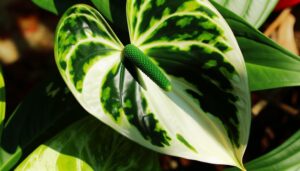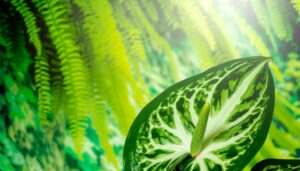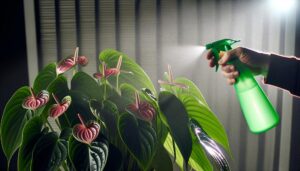What Makes Anthurium Vittarifolium Variegated Unique?
Anthurium Vittarifolium Variegated is unique due to its elongated, lanceolate leaves that exhibit striking variegation patterns of creamy white and vivid green.
These irregular patches result from a genetic mutation impacting chlorophyll distribution, enhancing light reflection and aesthetic appeal.
The plant’s dynamic coloration varies from stark white to subtle hues, influenced by both genetic mosaicism and environmental conditions. Its adaptability to epiphytic growth and need for bright, indirect sunlight, high humidity, and stable temperatures make cultivation challenging.
Limited availability due to propagation difficulties and high collector demand further accentuate its rarity. Explore more to understand its allure.
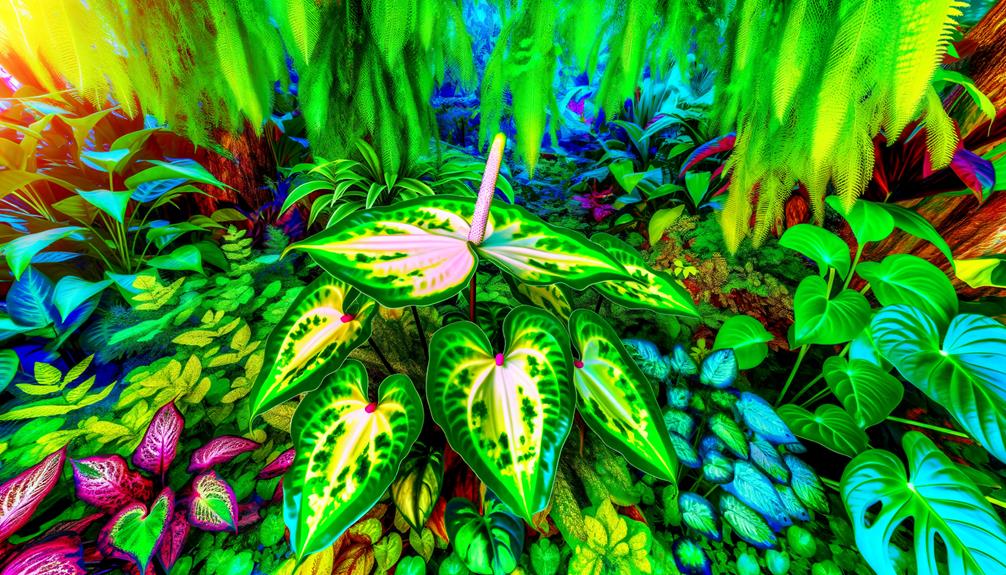
Key Takeaways
- Irregular patches of creamy white and vivid green variegation create a striking visual appeal.
- Genetic mosaicism and environmental factors contribute to diverse and unpredictable color variability.
- Long, lanceolate leaves with a smooth, glossy surface enhance its ornamental value.
- Limited availability and propagation challenges make it a highly coveted specimen.
- The plant’s epiphytic adaptability and cascading growth habit add architectural elegance.
Distinctive Leaf Shape
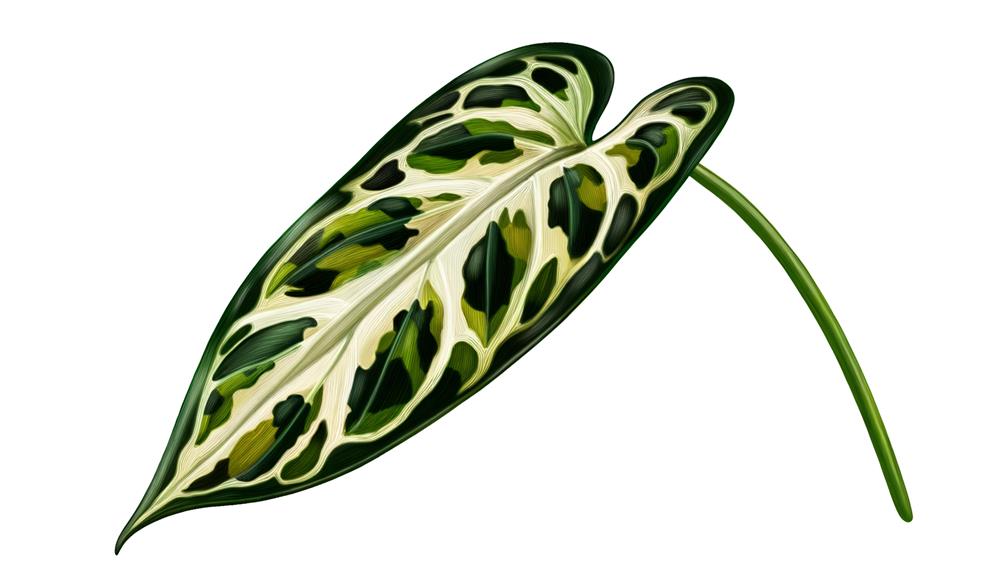
Characterized by its elongated, lanceolate leaves, the Anthurium vittarifolium variegated exhibits a distinctive leaf morphology that sets it apart from other members of the Araceae family.
The leaves, typically measuring between 50-100 cm in length, display a remarkable linearity and tapering at the ends. This shape not only contributes to its aesthetic appeal but also optimizes light capture and gas exchange, essential for photosynthesis.
The leaf surface is smooth, with a glossy texture that reduces transpiration rates. Additionally, the prominent midrib and parallel venation provide structural support, facilitating nutrient transport.
This unique leaf configuration enhances the plant’s adaptability to its native epiphytic environments, where light and moisture are often limited, underscoring its evolutionary specialization.
Striking Variegation Patterns
In addition to its distinctive leaf shape, the Anthurium vittarifolium variegated captivates with its striking variegation patterns, characterized by irregular patches of creamy white and vivid green that create a visually arresting contrast.
This variegation results from a genetic mutation affecting chlorophyll distribution, leading to areas of chlorotic tissue interspersed with normally pigmented cells.
The variegation pattern is not uniform; instead, it presents a stochastic distribution, offering a unique appearance to each leaf.
Moreover, the juxtaposition of pigmented and non-pigmented regions enhances light reflection, contributing to the overall luminance of the foliage.
These patterns are particularly pronounced along the leaf veins, underscoring the intricate venation network typical of the species and enhancing its horticultural appeal.
Color Variability
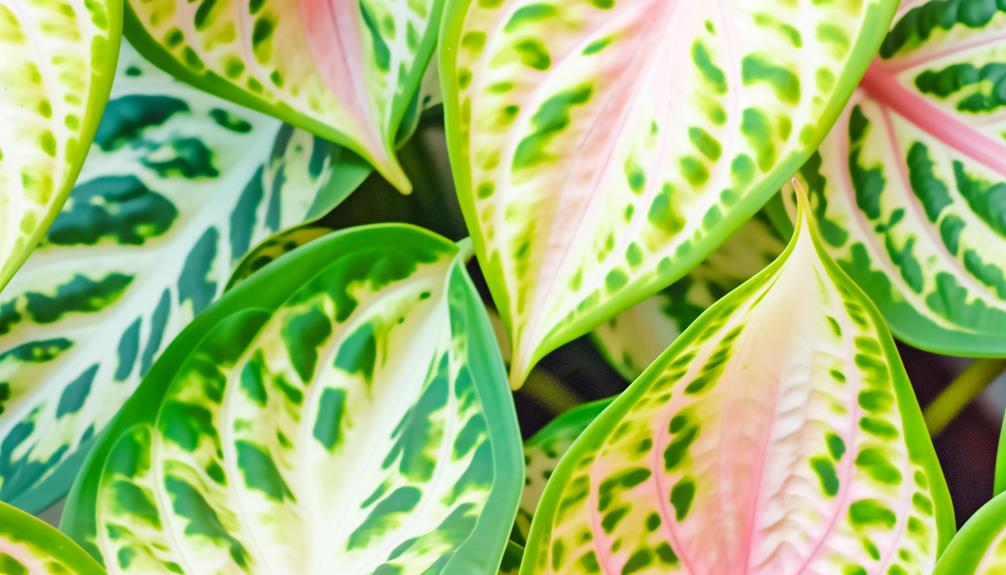
The Anthurium vittarifolium variegated shows significant color variability due to the dynamic interplay between genetic factors and environmental conditions.
Phenotypic expression of variegation can range from stark white variegation to subtle cream or yellowish hues, influenced by chlorophyll distribution and cellular mutations.
Seasonal changes, light intensity, and nutrient availability further modulate pigmentation, leading to an array of variegated patterns even within a single plant.
Genetic mosaicism, a primary driver, results in sectors of tissue with differing chloroplast function, thereby creating diverse coloration.
Environmental stressors such as photoperiod and temperature fluctuations can exacerbate or diminish these variegated expressions.
Consequently, the plant’s visual appeal is both unpredictable and fascinating, a proof of its complex biological mechanisms.
Growth Requirements
Anthurium Vittarifolium Variegated Unique requires specific environmental conditions to thrive at its best.
Ideal light conditions include bright, indirect sunlight, while maintaining a temperature range between 18-25°C is essential for its metabolic processes.
Additionally, consistent watering schedules and maintaining high humidity levels are necessary to prevent desiccation and achieve healthy variegation.
Light and Temperature
Perfect growth of Anthurium Vittarifolium Variegated Unique necessitates exposure to bright, indirect light and maintenance of temperatures between 65°F and 80°F.
This species flourishes under filtered sunlight, as direct exposure can lead to photodamage to the delicate variegated foliage. Optimum light conditions support robust photosynthesis, crucial for the plant’s variegated pattern.
Temperature stability is vital; fluctuating temperatures can induce stress, hindering growth and variegation. The plant’s native tropical habitat suggests a preference for consistent warmth. Hence, maintaining a stable environment, free from cold drafts or excessive heat, is essential.
Employing grow lights with adjustable intensity can replicate ideal light conditions, while thermometers and thermostats guarantee temperature accuracy, fostering a conducive environment for Anthurium Vittarifolium Variegated Unique.
Watering and Humidity
In addition to ideal light and temperature, maintaining appropriate watering practices and high humidity levels is vital for the health and growth of Anthurium Vittarifolium Variegated Unique.
This species thrives in consistently moist, well-draining soil, with overwatering leading to root rot. Watering should be done when the top inch of soil feels dry, ensuring the substrate remains aerated.
Relative humidity levels of 70-80% mimic its native tropical environment, promoting best physiological processes and variegation. Humidity can be increased using humidifiers or pebble trays filled with water.
Observations indicate that insufficient humidity results in leaf browning and reduced growth. These precise conditions are optimal to sustain the plant’s unique variegation and overall health.
Rare Availability
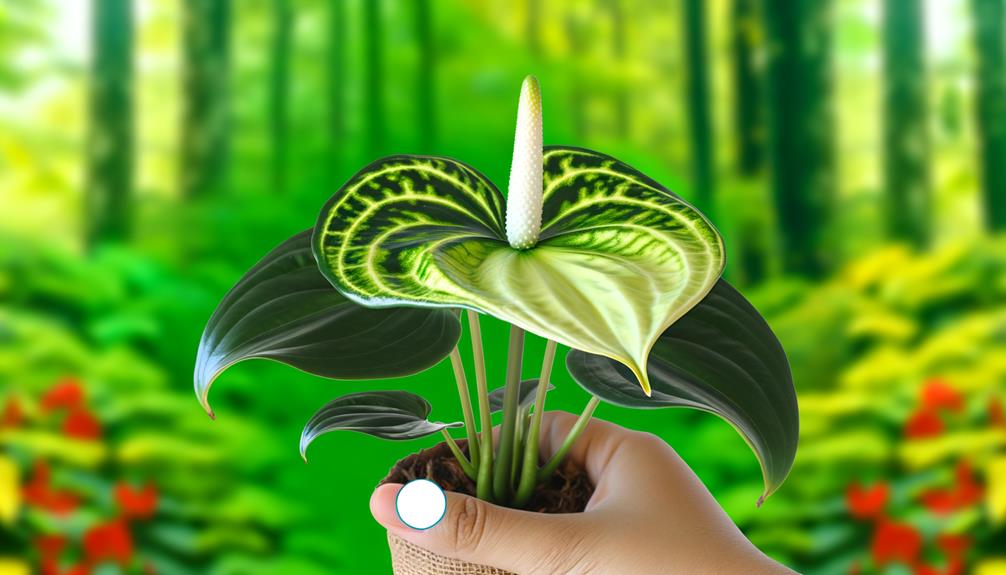
The scarcity of Anthurium Vittarifolium Variegated specimens in the horticultural market underscores its rarity and elevates its desirability among collectors and enthusiasts.
This scarcity is attributable to the plant’s specific environmental requirements and limited natural distribution.
Native to the tropical rainforests of South America, this variegated variant is seldom encountered in the wild due to its low frequency of occurrence.
Additionally, the intricate nature of its variegation—a genetic mutation resulting in striking white and green foliage—further limits its availability.
Variegation, being a relatively unstable genetic trait, complicates propagation efforts, thereby restricting the number of viable specimens. Consequently, its limited presence in commercial nurseries and botanical collections makes it a highly coveted specimen.
Propagation Challenges
Propagation of Anthurium Vittarifolium Variegated presents significant difficulties due to the instability of its variegated genetic trait and its demanding environmental requirements.
The variegation often results from chimeral mutations, making it genetically unstable and prone to reversion.
Key factors complicating propagation include:
- Genetic instability: Variegated plants may revert to their non-variegated form, losing their distinctive appearance.
- Environmental sensitivity: Optimal humidity, temperature, and light levels are essential for successful propagation.
- Slow growth rates: The plant’s slow vegetative growth hampers rapid multiplication.
- Susceptibility to disease: High susceptibility to pathogens such as root rot and fungal infections necessitates meticulous care.
These challenges necessitate advanced horticultural techniques and stringent monitoring to achieve successful propagation, ensuring the preservation of its unique variegated characteristics.
Ideal Growing Conditions
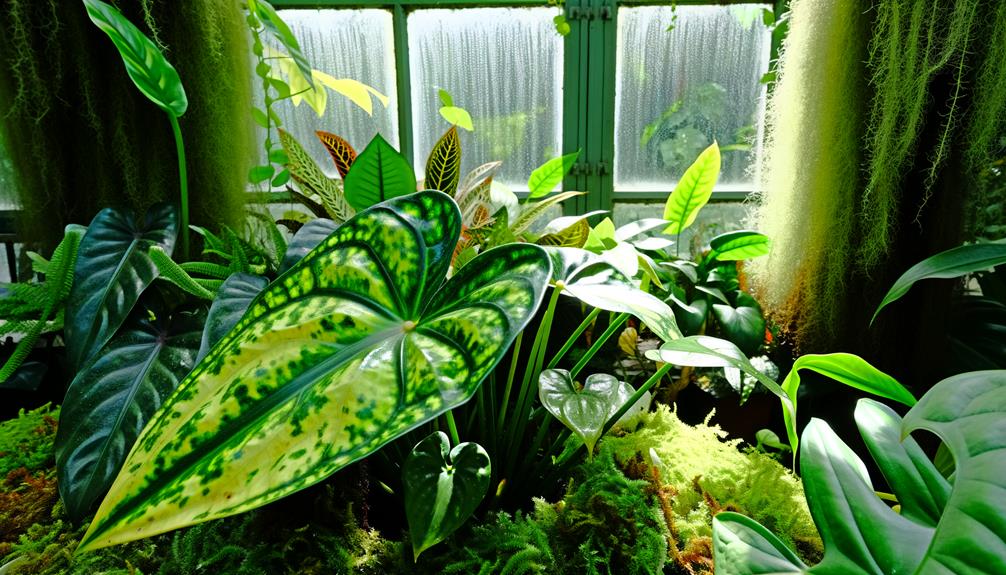
Peak growth of Anthurium Vittarifolium Variegated demands maintaining a controlled environment with precise humidity, temperature, and light conditions to ensure its variegated phenotype thrives.
Optimal humidity levels should consistently range between 70-80%, facilitated by regular misting or humidifiers.
Temperature parameters ideally span from 18-27°C (64-81°F), ensuring the plant remains within its thermal comfort zone.
Light exposure requires careful modulation; bright, indirect light is essential to prevent chlorophyll degradation, thereby maintaining the variegation.
Additionally, well-draining, aerated soil mixtures enriched with organic matter support root health and nutrient uptake.
Regular monitoring of these environmental factors, coupled with meticulous adjustments, is essential to replicate the plant’s native tropical habitat and sustain its ornamental appeal.
Collectors’ Appeal
The Anthurium Vittarifolium Variegated is highly sought after by collectors due to its rare variegation patterns, characterized by irregular and contrasting shades of green and white.
Additionally, its aesthetic plant structure, featuring elongated, strap-like leaves, adds a unique visual appeal.
The limited availability of this specific variegated variant further enhances its desirability within the horticultural community.
Rare Variegation Patterns
Collectors highly prize Anthurium vittarifolium variegated forms due to their intricate and rare variegation patterns, which result from genetic mutations affecting chlorophyll distribution.
These anomalies manifest in diverse and unpredictable designs that enhance the plant’s ornamental value.
Notable variegation patterns include:
- Sectorial Variegation: Large, distinct patches of white or cream contrasting against the green foliage.
- Mosaic Variegation: A checkerboard appearance where green and white areas intersperse irregularly.
- Marginal Variegation: Variegation concentrated along the leaf edges, creating striking borders.
- Speckled Variegation: Small, scattered spots or streaks of lighter color dispersed across the leaf surface.
Such rare and diverse patterns, coupled with their unpredictability, make each specimen unique, enhancing their appeal among horticultural enthusiasts and collectors.
Aesthetic Plant Structure
Anthurium vittarifolium variegated forms exhibit a distinctive growth habit characterized by elongated, pendant leaves that can reach several feet in length, contributing to their visual allure and desirability among plant collectors.
The variegation, with its intricate patterns of creamy white and green, enhances the aesthetic appeal, rendering each specimen unique.
The contrast between the variegated sections and the dark green foliage creates a dynamic visual texture.
Collectors appreciate the plant’s architectural elegance and the way its leaves cascade gracefully.
| Attribute | Description |
|---|---|
| Leaf Length | Up to several feet |
| Variegation Pattern | Creamy white and green |
| Growth Habit | Elongated, pendant |
| Visual Texture | Dynamic contrast |
This aesthetic structure elevates Anthurium vittarifolium variegated to a highly coveted status in botanical circles.
Limited Availability Factor
Due to its limited propagation and slow growth rate, Anthurium vittarifolium variegated remains a rare gem, intensifying its allure among dedicated horticulturists and plant enthusiasts. The scarcity factor is compounded by several critical elements:
- Propagation Challenges: The intricate process of vegetative propagation requires expert care, resulting in fewer available specimens.
- Natural Habitat Constraints: Native to specific tropical regions, its natural distribution is limited, reducing accessibility.
- Growth Rate: The plant’s inherently slow growth further restricts the supply, making mature specimens particularly prized.
- Market Demand: High demand from collectors exacerbates the scarcity, driving up market value.
These factors contribute to the plant’s esteemed status, making it a coveted addition for collectors seeking unique botanical specimens.
Conclusion
Anthurium vittarifolium variegated is distinguished by its unique leaf morphology, striking variegation patterns, and notable color variability. Its rarity and specific growth requirements, coupled with propagation challenges, add to its appeal among collectors.
Surprisingly, only approximately 5% of cultivated specimens exhibit the highly coveted variegation, making it a prized possession. These factors collectively contribute to its esteemed status in botanical collections and underscore the horticultural significance of this remarkable species.


